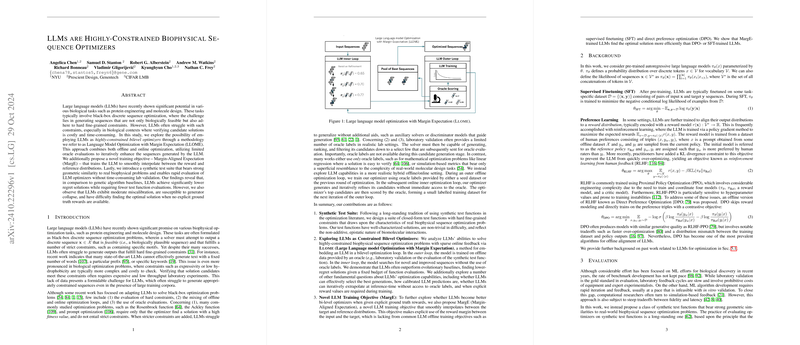Overview of "LLMs are Highly-Constrained Biophysical Sequence Optimizers"
This paper investigates the capabilities of LLMs as sophisticated tools for optimizing sequences in biophysical contexts, such as protein engineering and molecule design. These tasks often present as black-box discrete sequence optimization challenges, where the primary hurdles include generating biologically plausible sequences that comply with intricate constraints. The paper introduces a methodology called LLM Optimization with Margin Expectation (Llome) as an innovative use of LLMs in bilevel optimization frameworks to address this problem.
Methodology and Contributions
The core approach, Llome, employs LLMs in a bilevel optimization setting, which is characterized by an outer loop of offline optimization and an inner loop of online optimization without direct oracle feedback. The paper proposes a novel framework for handling the specific challenges of constrained sequence optimization in this domain:
- Synthetic Test Suite: The authors designed a synthetic test suite mirroring the geometrical complexity of real biophysical problems, which enables rapid evaluation of LLM optimizers without requiring lab validation. These synthetic Ehrlich functions provide a benchmark for assessing the ability of optimization algorithms to handle non-trivial biophysical sequence constraints.
- Exploring LLMs as Constrained Bilevel Optimizers: The paper leverages Llome to integrate LLMs effectively within a bilevel optimization loop, demonstrating superior performance over evolutionary methodologies. The focus is on generating lower-regret solutions with fewer oracle evaluations. This highlights the efficiency of LLMs in data-sparse environments common to biological research settings.
- Novel Training Objective (MargE): A novel LLM training objective, Margin-Aligned Expectation (MargE), was proposed to bridge the gap between reward-guided learning and reference distribution adherence. MargE is presented as an improvement over existing supervised finetuning (SFT) and direct preference optimization (DPO) techniques, particularly in navigating constrained optimization spaces.
Strong Numerical Results and Observations
The paper reports that, compared to benchmarks set by genetic algorithms, LLMs outfitted with the proposed Llome framework discover solutions with notably lower regret, indicating a higher degree of optimization with fewer evaluations. However, LLMs also face challenges such as moderate miscalibration, the risk of generator collapse, and difficulties in achieving solution optimality without explicit reward signals.
Implications and Future Directions
The findings underscore the potential for LLMs to significantly influence the field of biophysical optimization. They provide a compelling case for viewing LLMs as more than language processors, extending their utility into the field of complex, constraint-laden optimization tasks in biotechnology. Practically, this research suggests a path forward where LLMs are integrated into workflows requiring rapid, data-efficient iteration cycles, potentially revolutionizing fields like drug discovery and synthetic biology.
Theoretically, this work lays a foundation for further exploration into optimizing constrained systems using machine learning models by investigating alternative loss functions like MargE, which align generation capabilities with real-world constraints more effectively.
Conclusion
"LLMs are Highly-Constrained Biophysical Sequence Optimizers" offers a thoughtful and quantitatively robust exploration of how advanced LLMs can be adapted for intricate optimization tasks within the biophysical domain. This research not only broadens the application scope of LLMs but also sets a direction for future studies aiming to harness the full potential of machine learning in constrained optimization settings, which is crucial for advancing scientific discovery and technological innovation.
